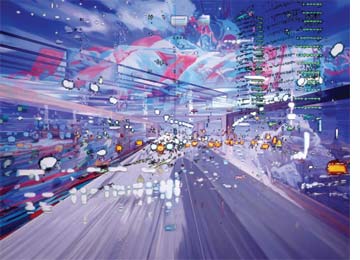
Ezeiza 2003
Corinne Wasmuht was born in 1964 in Dortmund, Germany and currently lives in Berlin. She is a contemporary artist that has been creating work since the 90s and continues to create work today. As such, she faces issues like globalization, economic crisis, proliferation of technology, modern warfare- all of the concerns that we feel today about the changing world can be considered influential on her life and work. Her current work is centered on creating an atmosphere that underlines that feeling of “information overload” resulting from today’s profusion of mass technology and media. Wasmuht’s paintings of overlapping images confuse orientation and clarity, and the sheer scale of them allows the audience to become completely enveloped by the realm that she has created. The non-hierarchical composition becomes fragmentary, as if one is constantly receiving bits of information and collaging them together in a jumbled incoherent mix.

Pathfinder 2002
The content of her work is seemingly at odds with her method of painting: a painstaking application of luminous glazes to create multiple layers that visibly illuminate the paneled wood on which she works. However, this method allows Wasmuht to create an ambiance of “electronic” light with images that seem to be illuminated from behind as if they were being projected, similar to the way a television or computer screen appears. This method also permits the viewer to see how slowly and deliberately she has worked on each image, making detailed and acute decisions that affect each image and the entire painting. I see this process as being one of her greatest strengths and her most successful artistic practice, because it allows her to communicate with the audience the intentionality behind her painting and create a sort of “alternative world” of technology and information that one can get lost in. I believe Wasmuht’s least successful method of working comes from her practice of limiting the images in her composition to being only those of which she has photographed herself and digitally transmitted. In this way, her hand is there at the beginning, and she limits her ability to allow for a moment of zero manipulation where it is only about gathering the images as they are, already transmitted in their own unique way.
No comments:
Post a Comment